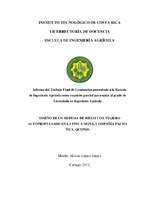Diseño de un sistema de riego con viajero autopropulsado en la finca Mona, Compañía Palma Tica, Quepos.
Abstract
The project was held in Palma Tica´s company. The same was to design a mobile irrigation system capable of irrigating land with steep slopes and with a maximum height of 30 m above the reference level.
The first thing we did was make a topographic survey to have quotas in the area, see obstacles, draw the pipe line and have a better idea of the behavior of the irrigation system, the topographic survey was done with GPS, GPS submeter and Laser distancemeters.
Subsequently, soil samples were taken in the field to bring them to the lab and get data about permanent wilting point, field capacity and soil structure and specific weight. Also, the infiltration speed was measured with infiltrometer. With the information from the physical characteristic of soil and climatic condition was done the agronomic design.
With the Agronomic design completed was carried out hydraulic design for a mobile irrigation. With the design is achieved irrigate 110 000 m2 in 22 hours; with a forward speed of 40 km / h and an irrigation frequency of 7 days for get a irrigation depth of 22, 86 mm. In addition, dealing 443 meters of pipe of 127 mm of diameter and a pump of 82 CV to make it work throughout the system. El proyecto se realizó en la compañía Palma Tica. El mismo consistió en diseñar un sistema de riego autopropulsado capaz de regar un terreno con pendientes fuertes y con una altura máxima de 30 m con respecto al nivel de referencia, que es la fuente de agua. Lo primero que se hizo fue hacer un levantamiento del terreno para tener cuotas del área, ver obstáculos y hacer el trazo de las tuberías, para así tener una mejor idea del comportamiento del sistema de riego. El levantamiento se hizo mediante GPS, GPS submétrico y un distanciómetro. Posteriormente, se sacaron muestras de suelo en el campo para llevarlas al laboratorio y obtener datos de punto de marchitez permanente, capacidad de campo, así como la estructura del suelo y peso específico. También, en el campo se midió la velocidad de infiltración mediante cilindros infiltró metros para obtener la infiltración básica. Con la información de las características físicas del suelo y datos de condiciones climáticas de la zona se completó el diseño agronómico. Una vez realizado el diseño agronómico, se llevó a cabo el diseño hidráulico, para un sistema de cañón móvil. Con el diseño se logra regar las 110 000 m 2 en 22 horas, con una velocidad de avance de 40 km/h y una frecuencia de riego de 7 días. Además, se ocupan 443 metros de tubería de 127 mm y una bomba de 82 CV para hacer que funcione todo el sistema.
Description
Proyecto de Graduación (Licenciatura en Ingeniería Agrícola) Instituto Tecnológico de Costa Rica, Escuela de Ingeniería Agrícola, 2011.


